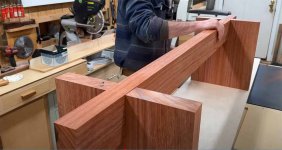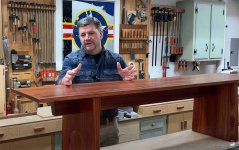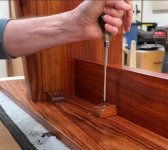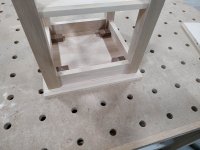smorgasbord
Member
Jon Peters has a nice simple low bench:=CMLKJoWkmyaChUok
But, even though the design has the grain of the top and base running in the same direction, he uses traditional buttons to attach the top, which aren't necessary since both top and base will move the same amount.
So, what's the best - or at least better - way to attach the top? I'm thinking buttons are more complex to build and install, and may not hold securely over time.
[attachimg=1]
[attachimg=2]
My first thought was, believe it or not, pocket screws. The legs are thick, so easy to put a pocket screw on the inside leg face going up into the also thick top. Maybe do 4 - one nearish (not too near) each corner. They really only take stress when you lift the bench by the top to move it around.
But, that's not elegant enough for some. Any better/easier options?
But, even though the design has the grain of the top and base running in the same direction, he uses traditional buttons to attach the top, which aren't necessary since both top and base will move the same amount.
So, what's the best - or at least better - way to attach the top? I'm thinking buttons are more complex to build and install, and may not hold securely over time.
[attachimg=1]
[attachimg=2]
My first thought was, believe it or not, pocket screws. The legs are thick, so easy to put a pocket screw on the inside leg face going up into the also thick top. Maybe do 4 - one nearish (not too near) each corner. They really only take stress when you lift the bench by the top to move it around.
But, that's not elegant enough for some. Any better/easier options?




